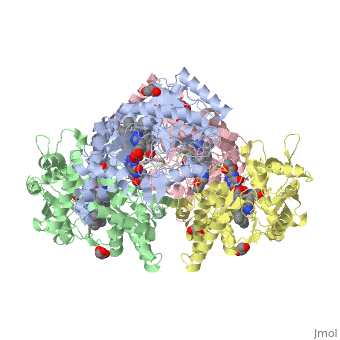Nos1
From Proteopedia
| Line 12: | Line 12: | ||
== Function == | == Function == | ||
| - | NOS1 is a major component of the production of Nitric Oxide. Nitric Oxide targets | + | NOS1 is a major component of the production of Nitric Oxide. Nitric Oxide targets Nitric Oxide specific receptors such as G-cyclase. Nitric oxide binds to the specific receptors to act as a major signaling molecule. NOS1 is an important component of synaptogenesis, long-term potentiation, neurotransmitter release and synaptic plasticity <ref>Juliane Kopf, Martin Schecklmann, Tim Hahn, Thomas Dresler, Alica C. Dieler, Martin J. Herrmann, Andreas J. Fallgatter, Andreas Reif. (2011) NOS1 ex1f-VNTR polymorphism influences prefrontal brain oxygenation during a working memory task, NeuroImage, Volume 57, (Issue 4),1617-1623, Ihttp://dx.doi.org/10.1016/</ref>. Synaptogenesis, long-term potentiation, neurotransmitter release and synaptic plasticity occur when NOS1 is coupled with N-methyl-D-Aspartate (NMDA) receptors in the post-synapse of cells.NMDA receptor binds to PSD95, which then binds to NOS1. After the complex is formed, NMDA receptor mediated CA2+ influx now regulates the amount of Nitric Oxide that is produced by NOS1 <ref>Freudenberg, F., Alttoa, A. & Reif, A. (2015) Neuronal nitric oxide synthase (NOS1) and its adaptor (NOS1AP) act as a genetic risk factors for psychiatric. Genes Brain Behav 14, 47–64.</ref>. |
| - | NOS1 also contributes in limiting oxidative stress in the myocardium, limits systolic and diastolic dysfunction and prevent a failing heart. NOS1 regulates the reuptake of Ca2+ in sarcoplamisic reticulum (SR). NOS1 is shown into the human coronary artery smooth cells and maintains of basal blood flow. NOS1 also controls the parasympathetic and sympathetic regulation of the heart<ref>Zhang, Y. H., Jin, C. Z., Jang, J. H., & Wang, Y. (2014). Molecular mechanisms of neuronal nitric oxide synthase in cardiac function and pathophysiology. The Journal of Physiology, 592(Pt 15), 3189–3200. http://doi.org/10.1113/jphysiol.2013.270306]</ref>. NOS1 is important in all functions that help regulate the cardiac muscles<ref>Zhang, Y. H., Jin, C. Z., Jang, J. H., & Wang, Y. (2014). Molecular mechanisms of neuronal nitric oxide synthase in cardiac function and pathophysiology. The Journal of Physiology, 592(Pt 15), 3189–3200. http://doi.org/10.1113/jphysiol.2013.270306]</ref>. The ability of Nitric Oxide to self regulate enables NOS1 to control all these major functions. In | + | NOS1 also contributes in limiting oxidative stress in the myocardium, limits systolic and diastolic dysfunction and prevent a failing heart. NOS1 regulates the reuptake of Ca2+ in sarcoplamisic reticulum (SR). NOS1 is shown into the human coronary artery smooth cells and maintains of basal blood flow. NOS1 also controls the parasympathetic and sympathetic regulation of the heart<ref>Zhang, Y. H., Jin, C. Z., Jang, J. H., & Wang, Y. (2014). Molecular mechanisms of neuronal nitric oxide synthase in cardiac function and pathophysiology. The Journal of Physiology, 592(Pt 15), 3189–3200. http://doi.org/10.1113/jphysiol.2013.270306]</ref>. NOS1 is important in all functions that help regulate the cardiac muscles<ref>Zhang, Y. H., Jin, C. Z., Jang, J. H., & Wang, Y. (2014). Molecular mechanisms of neuronal nitric oxide synthase in cardiac function and pathophysiology. The Journal of Physiology, 592(Pt 15), 3189–3200. http://doi.org/10.1113/jphysiol.2013.270306]</ref>. The ability of Nitric Oxide to self regulate enables NOS1 to control all these major functions. In myocyte relaxation, the Nitric Oxide produced by NOS1 facilitates SERCA to increase intracellular CA2+ because of the increase in PKA dependent PLN phosphorylation. |
== Disease == | == Disease == | ||
Revision as of 02:05, 28 April 2016
| |||||||||||
References
Shinkai, T., Ohmori, O., Hori, H., and Nakamura, J. (2002) Allelic association of the neuronal nitric oxide synthase (NOS1) gene with schizophrenia. Molecular Psychiatry. 7, 560-563. doi:10.1038/sj.mp.4001041 Galimberti, D., Scarpini, E., Venturelli, E., Strobel, A., Herterich, S., Fenogolio, C., Guidi, I., Scalabrini, D., Cortini, F., Bresolin, N., Lesch, K., and Reif, A. (2008) Association of a NOS1 promoter repeat with Alzheimer’s disease. Neurobiology of Aging. 29, 1359-1365. doi:10.1016/j.neurobiolaging.2007.03.003 Rife, T., Rasoul, B., Pullen, N., Mitchell, D., Grathwol, K., and Kurth, J. (2009) The effect of a promoter polymorphism on transcription of nitric oxide synthase 1 and its relevance to Parkinson’s disease. Journal of Neuroscience Research. 87, 2319-2325. doi:10.1005/jnr.22045
- ↑ UniProt Consortium 2009, ‘UniProtKB - P29475 (NOS1_HUMAN),’ UniProtKB Protein Knowledgebase
- ↑ Ward ME, Toporsian M, Scott JA, et al. Hypoxia induces a functionally significant and translationally efficient neuronal NO synthase mRNA variant. Journal of Clinical Investigation. 2005;115(11):3128-3139. doi:10.1172/JCI20806.
- ↑ Juliane Kopf, Martin Schecklmann, Tim Hahn, Thomas Dresler, Alica C. Dieler, Martin J. Herrmann, Andreas J. Fallgatter, Andreas Reif. (2011) NOS1 ex1f-VNTR polymorphism influences prefrontal brain oxygenation during a working memory task, NeuroImage, Volume 57, (Issue 4),1617-1623, Ihttp://dx.doi.org/10.1016/
- ↑ Freudenberg, F., Alttoa, A. & Reif, A. (2015) Neuronal nitric oxide synthase (NOS1) and its adaptor (NOS1AP) act as a genetic risk factors for psychiatric. Genes Brain Behav 14, 47–64.
- ↑ Zhang, Y. H., Jin, C. Z., Jang, J. H., & Wang, Y. (2014). Molecular mechanisms of neuronal nitric oxide synthase in cardiac function and pathophysiology. The Journal of Physiology, 592(Pt 15), 3189–3200. http://doi.org/10.1113/jphysiol.2013.270306]
- ↑ Zhang, Y. H., Jin, C. Z., Jang, J. H., & Wang, Y. (2014). Molecular mechanisms of neuronal nitric oxide synthase in cardiac function and pathophysiology. The Journal of Physiology, 592(Pt 15), 3189–3200. http://doi.org/10.1113/jphysiol.2013.270306]
Li H, Jamal J, Plaza C, et al. Structures of human constitutive nitric oxide synthases. Acta Crystallographica Section D: Biological Crystallography. 2014;70(Pt 10):2667-2674.

